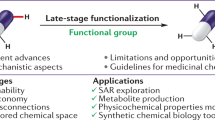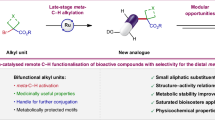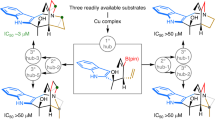Abstract
Pharmaceutical discovery efforts rely on robust synthetic methods that rapidly access diverse molecules. Cross-coupling reactions are the most widely used reactions, but these methods typically form bonds with C(sp2)-hybridized atoms and lead to a prevalence of ‘flat’ molecules with suboptimal physicochemical and topological properties. Benzylic C(sp3)–H cross-coupling offers an appealing strategy to address this limitation, as emerging methods exhibit synthetic versatility that rivals conventional cross-coupling to access drug-like products. Here we use a virtual library of benzylic ethers and ureas derived from benzylic C–H cross-coupling to test the widely held view that coupling at C(sp3)-hybridized centres affords products with improved three-dimensionality. The results show that the conformational rigidity of the benzylic scaffold strongly influences the product dimensionality. These concepts are validated through an informatics-guided synthesis and high-throughput experimentation to prepare three-dimensional products that are broadly distributed across drug-like chemical space.

This is a preview of subscription content, access via your institution
Access options
Subscribe to this journal
Receive 12 digital issues and online access to articles
$119.00 per year
only $9.92 per issue
Buy this article
- Purchase on Springer Link
- Instant access to full article PDF
Prices may be subject to local taxes which are calculated during checkout






Similar content being viewed by others
Data availability
The authors declare that all of the data supporting the findings of this study are available within the paper and its supplementary information file. Crystallographic data for the structures reported in this Article have been deposited at the Cambridge Crystallographic Data Centre, under deposition numbers CCDC 2164953. Copies of the data can be obtained free of charge via https://www.ccdc.cam.ac.uk/structures/. All raw data that support the findings of this study have been deposited at the figshare repository and may be obtained free of charge via https://doi.org/10.6084/m9.figshare.22213894.v2.
Code availability
Enumeration sequences and molecular property calculations described in this work are available for use as components in Pipeline Pilot. See Section 10 of Supplementary Information for the Python code used for PBF calculations and Section 11 for the R code used for PCA.
References
Blakemore, D. C. et al. Organic synthesis provides opportunities to transform drug discovery. Nat. Chem. 10, 383–394 (2018).
Dolle, R. E. in Chemical Library Design (ed. Zhou, J. Z.) 3–25 (Humana Press, 2011).
Lipinski, C. A., Lombardo, F., Dominy, B. W. & Feeney, P. J. Experimental and computational approaches to estimate solubility and permeability in drug discovery and development settings. Adv. Drug Deliv. Rev. 23, 3–25 (1997).
Lovering, F., Bikker, J. & Humblet, C. Escape from flatland: increasing saturation as an approach to improving clinical success. J. Med. Chem. 52, 6752–6756 (2009).
Sauer, W. H. B. & Schwarz, M. K. Molecular shape diversity of combinatorial libraries: a prerequisite for broad bioactivity. J. Chem. Inf. Comput. Sci. 43, 987–1003 (2003).
Boström, J., Brown, D. G., Young, R. J. & Keserü, G. M. Expanding the medicinal chemistry synthetic toolbox. Nat. Rev. Drug Discov. 17, 709–727 (2018).
Brown, D. G. & Boström, J. Analysis of past and present synthetic methodologies on medicinal chemistry: where have all the new reactions gone?: miniperspective. J. Med. Chem. 59, 4443–4458 (2016).
Brogden, R. N., Heel, H. C., Speight, T. M. & Avery, G. S. Fluriprofen: a review of its pharmacological properties and therapeutic use in rheumatic diseases. Drug. 18, 417–438 (1979).
Agoston, G. E. et al. Novel N-substituted 3α-[bis(4’-fluorophenyl)methoxy]tropane analogues: selective ligands for the dopamine transporter. J. Med. Chem. 40, 4329–4339 (1997).
Quasdorf, K. W., Riener, M., Petrova, K. V. & Garg, N. K. Suzuki−Miyaura coupling of aryl carbamates, carbonates, and sulfamates. J. Am. Chem. Soc. 131, 17748–17749 (2009).
Cernak, T., Dykstra, K. D., Tyagarajan, S., Vachal, P. & Krska, S. W. The medicinal chemist’s toolbox for late stage functionalization of drug-like molecules. Chem. Soc. Rev. 45, 546–576 (2016).
Zhang, Z., Chen, P. & Liu, G. Copper-catalyzed radical relay in C(sp3)–H functionalization. Chem. Soc. Rev. 51, 1640–1658 (2022).
Golden, D. L., Suh, S.-E. & Stahl, S. S. Radical advances in C(sp3)–H functionalization: foundations in for C–H cross coupling. Nat. Chem. Rev. 6, 405–427 (2022).
Taylor, R. D., MacCoss, M. & Lawson, A. D. G. Rings in drugs: miniperspective. J. Med. Chem. 57, 5845–5859 (2014).
Zhang, W., Chen, P. & Liu, G. Copper-catalyzed arylation of benzylic C–H bonds with alkylarenes as the limiting reagents. J. Am. Chem. Soc. 139, 7709–7712 (2017).
Zhang, W., Wu, L., Chen, P. & Liu, G. Enantioselective arylation of benzylic C−H bonds by copper‐catalyzed radical relay. Angew. Chem. Int. Ed. 58, 6425–6429 (2019).
Hu, H. et al. Copper-catalysed benzylic C–H coupling with alcohols via radical relay enabled by redox buffering. Nat. Catal. 3, 358–367 (2020).
Chen, S.-J., Golden, D. L., Krska, S. W. & Stahl, S. S. Copper-catalyzed cross-coupling of benzylic C–H bonds and azoles with controlled N-site selectivity. J. Am. Chem. Soc. 2021, 14438–14444 (2021).
Buss, J. A., Vasilopoulos, A., Golden, D. L. & Stahl, S. S. Copper-catalyzed functionalization of benzylic C–H bonds with N-fluorobenzenesulfonimide: switch from C–N to C–F bond formation promoted by a redox buffer and Brønsted base. Org. Lett. 22, 5749–5752 (2020).
Vasilopoulos, A., Golden, D. L., Buss, J. A. & Stahl, S. S. Copper-catalyzed C–H fluorination/functionalization sequence enabling benzylic C–H cross coupling with diverse nucleophiles. Org. Lett. 22, 5753–5757 (2020).
Zhang, Y. et al. A photoredox-catalyzed approach for formal hydride abstraction to enable Csp3–H functionalization with nucleophilic partners (F, C, O, N, and Br/Cl). Chem Catal. 2, 292–308 (2022).
Lopez, M. A., Buss, J. A. & Stahl, S. S. Cu-catalyzed site-selective benzylic chlorination enabling net C−H coupling with oxidatively sensitive nucleophiles. Org. Lett. 24, 597–601 (2022).
Suh, S.-E., Nkulu, L. E., Lin, S., Krska, S. & Stahl, S. S. Benzylic C–H isocyanation/amine coupling sequence enabling high-throughput synthesis of pharmaceutically relevant ureas. Chem. Sci. 12, 10380–10387 (2021).
Guillemard, L., Kaplaneris, N., Ackermann, L. & Johansson, M. J. Late-stage C–H functionalization offers new opportunities in drug discovery. Nat. Rev. Chem. 5, 522–545 (2021).
Sambiagio, C., Marsden, S. P., Blacker, A. J. & McGowan, P. C. Copper catalysed Ullmann type chemistry: from mechanistic aspects to modern development. Chem. Soc. Rev. 43, 3525–3550 (2014).
Dorel, R., Grugel, C. P. & Haydl, A. M. The Buchwald–Hartwig amination after 25 years. Angew. Chem. Int. Ed. 58, 17118–17129 (2019).
Dunetz, J. R., Magano, J. & Weisenburger, G. A. Large-scale applications of amide coupling reagents for the synthesis of pharmaceuticals. Org. Process Res. Dev. 20, 140–177 (2016).
Prosser, K. E., Stokes, R. W. & Cohen, S. M. Evaluation of 3-dimensionality in approved and experimental drug space. ACS Med. Chem. Lett. 11, 1292–1298 (2020).
Wu, G. et al. Overview of recent strategic advances in medicinal chemistry. J. Med. Chem. 62, 9375–9414 (2019).
Medina-Franco, J., Martinez-Mayorga, K., Giulianotti, M., Houghten, R. & Pinilla, C. Visualization of the chemical space in drug discovery. Curr. Comput. Aided Drug Des. 4, 322–333 (2008).
Kutchukian, P. S. et al. Chemistry informer libraries: a chemoinformatics enabled approach to evaluate and advance synthetic methods. Chem. Sci. 7, 2604–2613 (2016).
Greshock, T. J. et al. Synthesis of complex druglike molecules by the use of highly functionalized bench-stable organozinc reagents. Angew. Chem. Int. Ed. 55, 13714–13718 (2016).
Bickerton, G. R., Paolini, G. V., Besnard, J., Muresan, S. & Hopkins, A. L. Quantifying the chemical beauty of drugs. Nat. Chem. 4, 90–98 (2012).
Firth, N. C., Brown, N. & Blagg, J. Plane of best fit: a novel method to characterize the three-dimensionality of molecules. J. Chem. Inf. Model. 52, 2516–2525 (2012).
Chen, F., Huang, G. & Huang, H. Sugar ligand-mediated drug delivery. Future Med. Chem. 12, 161–171 (2020).
Heidel, K. M. & Dowd, C. S. Phosphonate prodrugs: an overview and recent advances. Future Med. Chem. 11, 1625–1643 (2019).
Tice, C. M. et al. Spirocyclic ureas: orally bioavailable 11β-HSD1 inhibitors identified by computer-aided drug design. Bioorg. Med. Chem. Lett. 20, 881–886 (2010).
Tichenor, M. S. et al. Heteroaryl urea inhibitors of fatty acid amide hydrolase: structure–mutagenicity relationships for arylamine metabolites. Bioorg. Med. Chem. Lett. 22, 7357–7362 (2012).
Vardanyan, R. in Piperidine-Based Drug Discovery 103–125 (Elsevier, 2017).
Wallace, H. M., Fraser, A. V. & Hughes, A. A perspective of polyamine metabolism. Biochem. J 376, 1–14 (2003).
Krska, S. W., DiRocco, D. A., Dreher, S. D. & Shevlin, M. The evolution of chemical high-throughput experimentation to address challenging problems in pharmaceutical synthesis. Acc.Chem. Res. 50, 2976–2985 (2017).
Dombrowski, A. W., Aguirre, A. L., Shrestha, A., Sarris, K. A. & Wang, Y. The chosen few: parallel library reaction methodologies for drug discovery. J. Org. Chem. 87, 1880–1897 (2022).
MacroModel Release 2019-3 (Schrödinger, LLC, 2019).
Roos, K. et al. OPLS3e: extending force field coverage for drug-like small molecules. J. Chem. Theory Comput. 15, 1863–1874 (2019).
Wenderski, T. A., Stratton, C. F., Bauer, R. A., Kopp, F. & Tan, D. S. in Chemical Biology: Methods and Protocols (eds Hempel, J. E. et al.) 225–242 (Humana Press, 2015).
Tukey, J. W. Exploratory Data Analysis (Addison-Wesley Publishing Co., 1977).
Acknowledgements
We thank S.-E. Suh for helpful discussions about applications of the benzylic C–H isocyanation–urea synthesis, T. G. Greshock for suggestions on the PCA and HTE, I. A. Guzei and K. M. Sanders for assistance with X-ray crystallographic characterization of A16-1, B. A. Parvizian for LC–MS support and A. Bleskacek for assistance with melting point and optical rotation measurements. This work was supported by the National Institutes of Health (NIH) (R35 GM134929, to S.S.S.) and Merck & Co., Inc., Kenilworth, NJ, USA (travel funds to S.-J.C.). Spectroscopic instrumentation was supported by a gift from P. J. Bender, the NSF (CHE-1048642) and the NIH (S10 OD020022).
Author information
Authors and Affiliations
Contributions
This project was conceived by S.S.S., in collaboration with S.W.K. and S.-J.C. S.-J.C. performed the informatics studies and experiment work and led the data interpretation and analysis. M.K. and J.W. supported purification of selected products in high-throughput synthesis. C.Q.H. performed conformational analysis and provided guidance and insights into library enumeration, PCA and PMI analysis. S.-J.C. and S.L. selected the alcohol and amine building blocks for library enumeration. All work was done in consultation with S.W.K. and S.S.S. All authors contributed to preparation of the paper.
Corresponding author
Ethics declarations
Competing interests
The authors declare no competing interests.
Peer review
Peer review information
Nature Synthesis thanks György Keserű, Peng Zhan and the other, anonymous, reviewer(s) for their contribution to the peer review of this work. Primary Handling Editor: Thomas West, in collaboration with the Nature Synthesis team.
Additional information
Publisher’s note Springer Nature remains neutral with regard to jurisdictional claims in published maps and institutional affiliations.
Supplementary information
Supplementary Information
General experimental considerations, enumeration workflows, PCA plots information (Section 6), characterization of compounds (Section 12), Supplementary Figs. 1–6 and Tables 1–11.
Supplementary Data 1
Crystallographic data for A16-1, CCDC 2164953.
Supplementary Data 2
Sample structure input for PBF procedure demonstration.
Supplementary Data 3
Sample data output for PBF procedure demonstration.
Supplementary Data 4
Sample data input for PCA procedure demonstration.
Supplementary Data 5
Sample data output for PCA procedure demonstration.
Supplementary Data 6
Procedure operations instructions for PCA and PBF calculations.
Rights and permissions
Springer Nature or its licensor (e.g. a society or other partner) holds exclusive rights to this article under a publishing agreement with the author(s) or other rightsholder(s); author self-archiving of the accepted manuscript version of this article is solely governed by the terms of such publishing agreement and applicable law.
About this article
Cite this article
Chen, SJ., He, C.Q., Kong, M. et al. Accessing three-dimensional molecular diversity through benzylic C–H cross-coupling. Nat. Synth 2, 998–1008 (2023). https://doi.org/10.1038/s44160-023-00332-4
Received:
Accepted:
Published:
Issue Date:
DOI: https://doi.org/10.1038/s44160-023-00332-4



